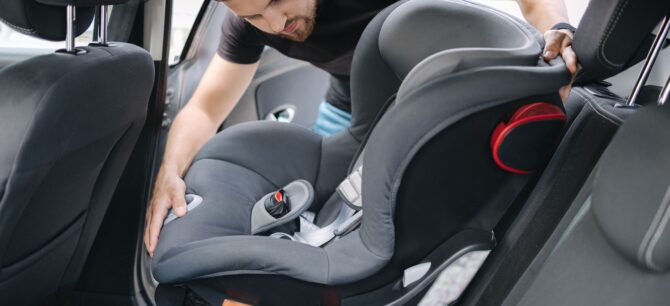Do You Have to Replace a Car Seat After an Accident?

Parents may wonder whether they must replace their child’s car safety seat after their vehicle gets into an accident. The National Highway Traffic Safety Administration (NHTSA), which enforces vehicle performance standards in the U.S., says car seats do not automatically need to be replaced following a minor crash but that you should always follow the car seat manufacturer’s instructions.
According to NHTSA, you should “NEVER use a car seat that has been involved in a moderate to severe crash.”
NHTSA estimates that car seats reduce the risk of fatal injury by 71% for infants (younger than one year old) and by 54% for toddlers (1 to 4 years old) in passenger cars. That’s why it’s essential to correctly use the right car seat every time your child is in the car. You can register your car seat to receive alerts about any recalls affecting it.
At Chiumento Law, PLLC, our Palm Coast car accident lawyers help victims of car crashes recover compensation for their medical bills, vehicle damage, and other losses. When necessary, we can help the parents of an injured child file a personal injury lawsuit against the at-fault driver. We hope all parents in Florida will protect their young children by properly using a child safety seat.
Remember, Florida law requires children up to 5 years old to be properly secured in a crash-tested, federally approved child restraint device when riding in a motor vehicle. Children up to age three must be in child restraint devices of a separate carrier or a vehicle manufacturer’s integrated child seat. Children ages 4 and 5 must be in a separate carrier, integrated child seat, or booster seat.
When Should You Replace Child Car Seats After an Accident?
NHTSA recommends that parents replace car seats after a moderate or severe crash to ensure a continued high level of crash protection for children using the seat. Car seats do not automatically need to be replaced following a minor crash.
NHTSA says a minor car accident is one in which ALL of the following apply:
- The vehicle could be driven away from the crash site.
- The vehicle door nearest the car seat was not damaged.
- None of the passengers in the vehicle were injured in the crash.
- The vehicle airbags did not deploy during the crash.
- There is no visible damage to the car seat.
These guidelines apply regardless of whether a child was in the car seat during the accident.
Manufacturers Recommend New Children’s Car Seats After Crashes
Car seat manufacturers often recommend replacing a car seat after any crash. “Even if there appears to be no damage to the car seat on the surface, the impact and force of a collision can cause unseen internal structural damage to your car seat,” car seat manufacturer Graco says. “Any such damage may prohibit your car seat from properly protecting your child in the event of a sudden stop or crash.”
Car seat manufacturer Chicco has the same message. The company says, “Yes, you must replace your car seat and base if it has been involved in a vehicle crash, even if you can’t see visible damage. A damaged car seat or base may not protect your child in a future accident.”
Most manufacturers make the same recommendation. Others quote NHTSA guidelines and the agency’s definition of a “minor” car accident.
If you don’t have your car seat user’s guide, find the manufacturer and model names on the car seat and search with them online to find the manual or the manufacturer’s website for more information.
Are Children’s Car Seats Covered By Auto Insurance?
Automotive comprehensive or collision insurance policies typically pay to replace a car seat after a crash, depending on the cause of the accident. If you only have liability insurance, you probably won’t be able to recover compensation to replace a car seat through your own insurance policy.
If another party is at fault for a car accident, you may be able to compel their liability insurance carrier to reimburse you for the cost of a new car seat. A car accident lawyer from Chiumento Law, PLLC, can help you submit an insurance claim.
To prepare a property damage claim for a damaged car seat part of your personal injury claim, you should gather the following:
- Receipt for the car seat. If purchased with a credit or debit card, your credit card provider or bank should have a record of the purchase online.
- Car seat’s serial number and expiration date. Look at the seat itself, under the lining.
- Photos of the damaged vehicle.
- Photos of the car seat’s cut straps. Cut the car seat’s straps to ensure the seat cannot be used again.
The car seat’s expiration date is important. Insurance companies are unlikely to reimburse you for an expired car seat. Car seats made by Evenflo, for example, mostly expire six years after the date of manufacture.
“Safety standards change over time as restraint technology develops,” Evenflo says. “Expiration dates help ensure that you are not using a car seat that may be secondhand, has been in an accident, or has missing or damaged parts. An expiration date provides a gentle reminder that it is time to buy a new seat with the latest technology and safety features.”
Get in Touch with Our Car Accident Lawyers
Talking to an experienced car accident lawyer after a collision can help you understand your legal options and safeguard your rights, including your right to be compensated for losses caused by someone else’s negligence. Chiumento Law, PLLC in Palm Coast, Florida, has more than 50 years of experience and the resources to handle both major and minor car accidents effectively.
Contact us online or at (386) 445-8900 today for a free consultation. Find out how we can fight for maximum compensation on your behalf.
